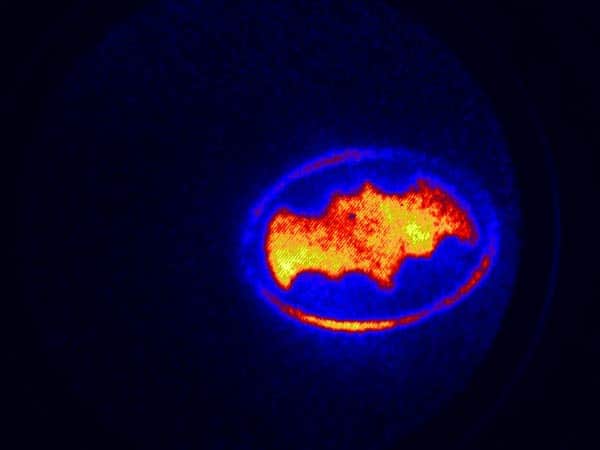
Researchers in Australia have developed a new source of cold electrons that could be useful for imaging tiny structures at atomic-length scales. The source, which makes use of ultracold atoms, can deliver intense and coherent electron pulses with specific shapes – including the Batman motif shown above. According to the team, such pulses could be used in the diffraction imaging of biological molecules, viruses and nanostructures.
Robert Scholten and colleagues at the University of Melbourne begin with a cloud of about one billion rubidium atoms that are laser-cooled to a few millionths of a degree above absolute zero. The team then fires two laser pulses at the atoms. The first pulse puts the atoms in an excited electronic state. The second pulse provides just enough energy to liberate those electrons and create a pulse of cold electrons with a temperature of about 10 K. Electron pulses with complex shapes can be created by passing the first pulse through a spatial light modulator before it strikes the atoms.
The pulses are then accelerated to 1 keV using an electric field and then allowed to drift about 21 cm before being detected. Unlike pulses from a conventional, hot-electron source that blur rapidly from the random motion of the electrons, these pulses retain their shapes when detected.
High spatial coherence
Because the electron pulses retain their shape, they have a high degree of spatial coherence perpendicular to their direction of travel. This makes them ideal for diffractive imaging – which the researchers hope to carry out in the coming months. According to Scholten, the transverse coherence length is about 10 nm at the source, which is already good enough to do diffraction imaging of large biomolecules as well as small viruses.
“High spatial coherence means that [the electrons] propagate in a very parallel beam, so when they hit a target, we know where they came from,” explains Scholten. “If we then detect them after diffracting from the target, we know where they came from and where they were detected,” he adds. This information is used to infer the diffractive effect of the target, which is related to its structure. Such imaging systems would complement existing atomic-force microscopy (AFM) and electron-microscopy techniques.
Being able to shape the pulses should also help researchers get round the phenomenon of “Coulomb explosion”, which is a fundamental barrier to creating bright electron pulses. Because electrons have electrical charge, the particles repel each other, thereby causing the pulse to expand as it travels – reducing its intensity. However, if the pulse is created with a specific shape – a uniform-density ellipsoid – Scholten says that it can be refocused using standard electron optics to cancel out the effects of the Coulomb explosion.
“Leapfrog arrangement”
Scholten is quick to point out that the original idea for how to create shaped pulses of cold electrons came from Edgar Vredenbregt, Jom Luiten and colleagues at the Technical University of Eindhoven in the Netherlands. As well as setting out the theory, the Dutch researchers have also worked on electron sources. “We work closely with them and, indeed, they are now adopting the techniques we [have developed], and we are sending them engineering drawings of our system,” says Scholten. “It’s a leapfrog arrangement – we built on what they did using their experiences and suggestions to progress, and now we are returning the favour.”
Thomas Killian of Rice University in Texas tells
The research is published in Nature Physics 10.1038/nphys2052.



